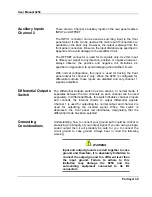
User Manual 9250
1-6 Portrayal
output level accuracy. For example, with properly
terminated signals at the input and output
connectors (say 50
Ω
each), an input of 2Vp-p will
generate an output of 20Vp-p. On the other hand, if
you increase your load impedance by a large
factor, the output will increase by a factor of:
Vout = 40Vp-p - 40Vp-p x 50
Ω
/ (50
Ω
+X
Ω
)
where X = your load impedance
If you look at the equation above, with exactly 50
Ω
load impedance, the output will be 20Vp-p and as
you increase the load impedance, the output
increases proportionally until, at very high load
impedance, the output is doubled to 40Vp-p.
40Vp-p is the maximum amplitude level this amplifier can produce
however, only into high impedance loads.
WARNING
Applying the output signal on inductive or
capacitive loads may damage the amplifier.
Channel 2 Output
The channel 2 output connector outputs amplified signals. When
the 9250 is configured as two separate amplifiers, this output
generates amplified signals that are applied to the channel 2 input
connector. If the instrument is configured for differential output, this
channel generates an inverted signal at 180
°
phase offset while
channel 1 output generates the normal, non-inverted.
Gain at this output is fixed at 10 (or another gain factor that was
specified at the time of your purchase). Output source impedance
is one of: 50
Ω
, 75
Ω
or 600
Ω
.
Tip
Knowing your source impedance is very important
because the output gain accuracy is calibrated to
specific source impedance and therefore, any
unmatched load impedance may have an affect on
output level accuracy. For example, with properly
terminated signals at the input and output
connectors (say 50
Ω
each), an input of 2Vp-p will















































